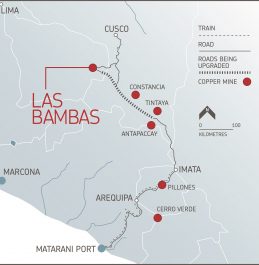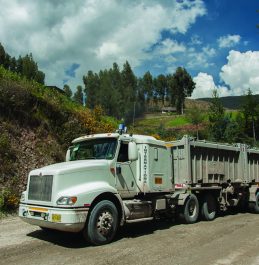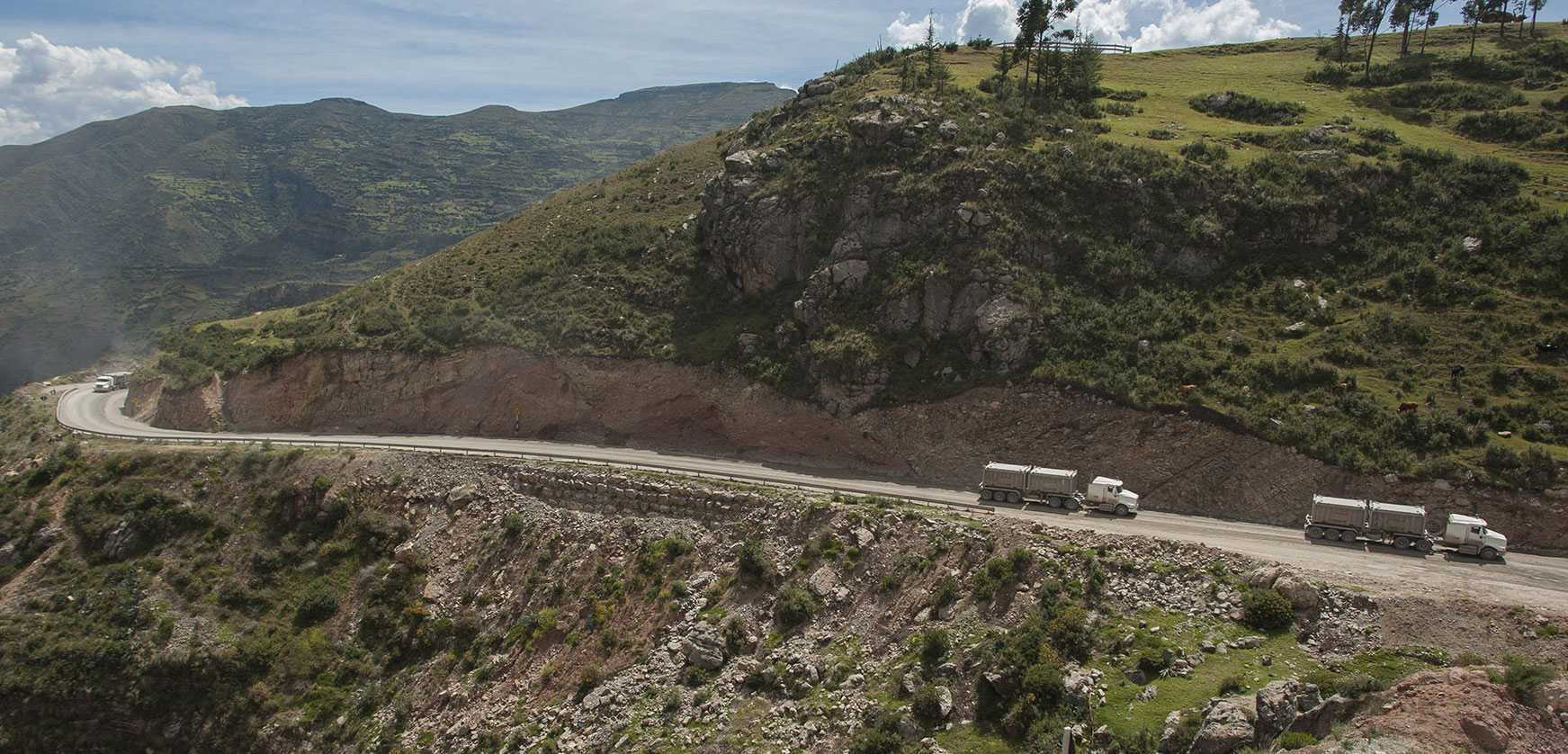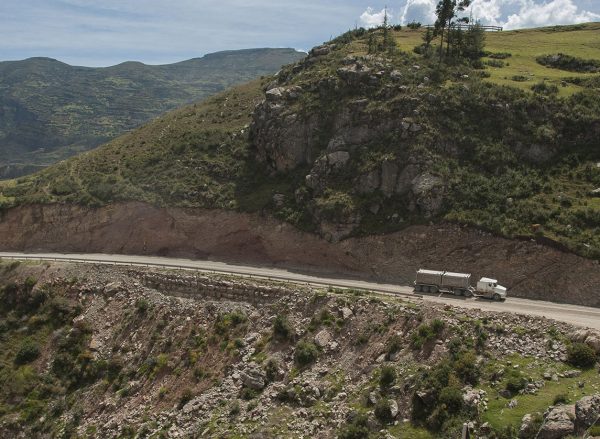The Las Bambas operation in Apurimac, Peru is a large, long life copper mine.
In recent times, the communities located on the road to Las Bambas have gone through significant changes with the upgrade of local infrastructure, including roads. Traffic has increased on these remote roads as production has ramped up to commercial rates during 2016 in a difficult and challenging mountainous region.
The road and rail corridor that starts at Las Bambas, passes important operations such as Antapaccay, Constancia and Cerro Verde on the way to the world’s largest concentrate port at Matarani. The road traverses three regions, five provinces, 14 districts and 60 communities.
This Q&A has been developed to provide an open, transparent account of the transportation of copper concentrate from the mine to the Port of Matarani.
Q. How is copper concentrate transported to the Port of Matarani?
- Copper concentrate is transported 458km by truck to Pillones Station, where it is transported a further 286km by train to the Port of Matarani.
- The trucks each transport two 17.3 tonne containers, transferring upwards of 3,600 wet metric tonnes, and equivalent to 106 trucks per day.
Q. What processes are being taken to limit the impact of the trucks?
- All containers involved in the transport of copper concentrate are sealed to prevent any accidental spillage.
- Prior to trucks passing, the road is watered to reduce the disturbance of the road and resultant dust.
- Las Bambas is currently sealing more than 80 km of road with micro paving within and around the communities where trucks pass. This work continues.
Q. How is MMG ensuring safety for the drivers and community?
- There is a team of more than 700 truck drivers and 100 escort drivers involved in the trucking of concentrate to Pillones Station.
- MMG is committed to the safety of every single one of these drivers and the community. Following the tragic death on Thursday 21 July of Felipe Leon Chavez, a driver who was employed through our logistics contractor Transaltisa, Las Bambas has been actively implementing initiatives to reduce fatigue and increase road safety.
- Some of these include; MMG has a strict no drugs or alcohol policy and regular testing is undertaken, internal and external cameras in each truck to alert fatigued drivers, bracelets for rest control for each driver as well as preventive and corrective maintenance programs.
Q. How will the investment in road infrastructure benefit the community?
- The investment in the road will continue to improve access and economic opportunities for local communities. Increase in traffic and transportation of goods will provide communities with new markets and possibilities. A reduction in transit time will provide communities with greater access to a host of services, a trip from Challhuahuacho to Arequipa will now take 7 hours less on the improved road.
Q. What issues have occurred between the use of the road and the community?
- Dust and noise from the trucks has been an issue for communities. Increased wetting of the road to reduce dust and investing in road improvements has been undertaken to mitigate community concerns.
- Our activities are underpinned by a grievance mechanism that is consistent with the remedy mechanisms under the UN Business and Human Rights Framework
- Las Bambas has invested more than USD$ 246 million into road improvement and maintenance.
Q. How have communities been engaged through this process?
- Las Bambas has worked for many years with the surrounding communities on access and road use agreements and road upgrades.
- The team at Las Bambas is committed to working with local communities to find long term, sustainable solutions to concerns, including noise and dust as a result of concentrate transport. The team is also working closely with the Peruvian Government as well as regional and community leaders along our transport corridor.
- We have a team at each one of the communities where the material is transported through.
- All the changes and improvements made to the project have been communicated and in compliance with required regulatory standards.
Q. What is the process of shipping concentrate from Pillones Station to the Port of Matarani?
- The train has a capacity for 54 containers, and is 348 meters long. Up to four trains can run per day, and it takes approximately 36 hours for the train to travel from Pillones Station to the Port of Matarani.
Q. What is the percentage of drivers who come from the local area?
- Currently 10% of drivers are from the local area, with a plan in place to grow this to 50% by 2018.
秘鲁Apurimac区的 Las Bambas矿山是一个规模大、年限长的铜矿。 近期,Las Bambas 进出道路沿线的社区经历了很大的变化,包括公路等基础设施的升级。
该矿山坐落于偏僻的和具挑战性的山区,随着产量提升,这些偏僻公路的通行车辆增加了。
从Las Bambas开始的公路和铁路长廊,途中穿过大型运营(如Antapaccay、Constancia和 Cerro Verde),然后到达世界最大的精矿港口Matarani。公路经过三个大区、六个省份、十六个区域和八十六个社区。
Las Bambas精矿公路铁路联运
铜精矿通过公路运输 458公里至 Pillones中转站,然后经铁路运输286公里至 Matarani港口。 火车承载54个集装箱,总长348米。每天最多可派发4班火车,Pillones中转站至 Matarani港口全程需时36小时。每天大约106 辆卡车装载两个 17.3吨的集装箱,每天运输约3,600湿吨精矿。
所有运输铜精矿的集装箱都是全封闭的,以防撒漏。在卡车经过之前,洒水车先洒水以降低扬尘。Las Bambas现在对卡车经过社区的80公里公路铺设路面。
车队有700多名卡车司机和100名护送司机。司机和社区居民的安全是首要任务。卡车内外均安装了摄像头和警钟以提醒出现疲劳征兆的司机。每名司机佩戴检测手环,以检测微睡眠,预防和调整措施定期展开。 目前司机中10%来自当地,计划2018年上升到50%。
很不幸,虽然建立了好的管控机制,我们物流承包商Transaltisa公司雇员 Felipe Leon Chavez先生仍于7月21日星期四发生的一起交通意外中不幸丧生。Las Bambas已积极实施各种举措,并将教训学以致用,以降低疲劳驾驶,提高运输安全。
社区机会和影响
Las Bambas投资了2.4亿美元用于升级进出矿山的公路、增加公路进出口,并为整个区域提高经济机会。运输与车辆的增加为社区提供了新市场和机会。例如:从Challhuahuacho到 Arequipa的道路升级后车程缩短了7小时。
Las Bambas与周围社区就进出和使用公路及道路升级协议商谈了多年。 如同预期,公路进出口增加后,交通量、噪音和扬尘就会增加。已开展公路洒水以减少扬尘并投资于公路升级等工作,以减少影响并应对社区的担忧问题。
Las Bambas团队致力于与当地社区和秘鲁交通当局共同合作,寻求长期可持续的解决方案。公路沿线的每个社区都安驻了社区关系团队,以提供定期的沟通和支持。由秘鲁政府、Las Bambas团队和其他区域利益相关方组成的工作组正在按照国家公路标准起草一份公路升级及铺设建议。
图: 我们的精矿通过公路和铁路运输到Arequipa的 Matarani港口,然后再海运至世界各地的客户。
-
 铜运输路线图
铜运输路线图 -
 Las Bambas卡车运输铜精矿
Las Bambas卡车运输铜精矿




